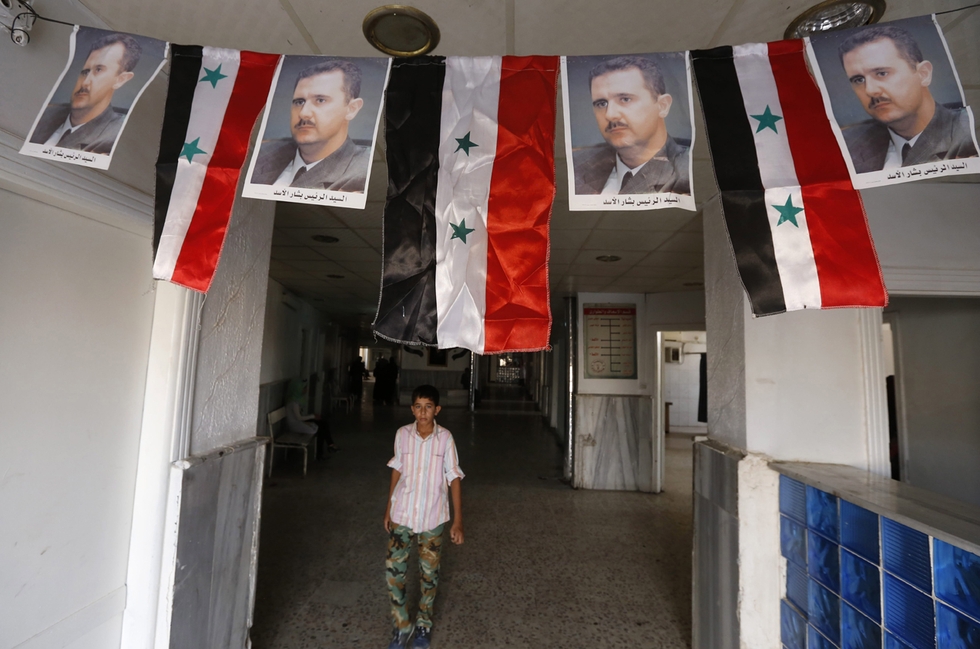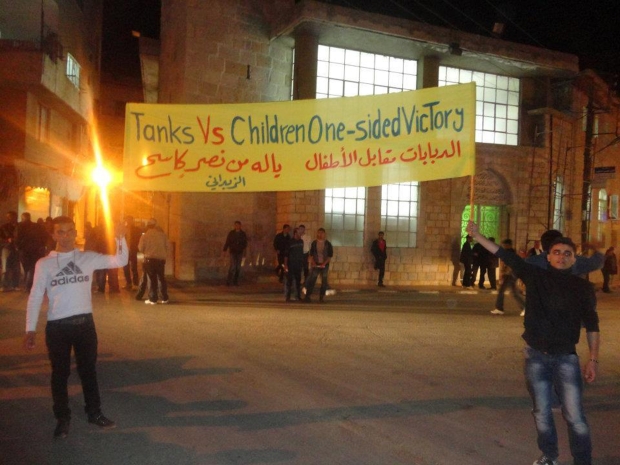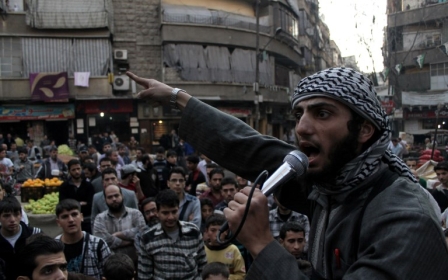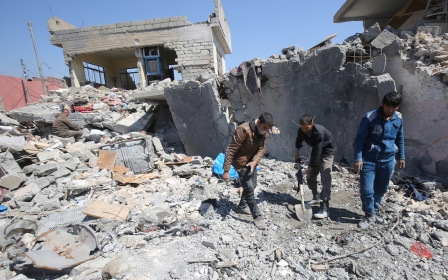What we really mean when we say ‘liberated’ in Syria

Earlier this month, during a UN Humanitarian Task Force update, UN Special Envoy to Syria Staffan de Mistura solemnly proclaimed that “a moment of truth” was coming in the Syrian war.
With the advance on Deir Ezzor and the impending defeat of the Islamic State (IS) group in Raqqa, de Mistura suggested that it was increasingly likely that, for many of the international actors who became involved in the conflict to fight IS, their work was nearly over.
Or to use Donald Trump’s language, the “destruction” of IS was complete, and for de Mistura and the UN this signified the transformation of those key areas into “liberated zones”.
Both Western and Arab governments have equated victory against Islamist groups with this notion of liberation, as if these groups are the only threat to progressive notions of justice and security
“Deir Ezzor is almost liberated. In fact, it is as far as we are concerned,” he said during the press conference on 6 September. “The next one is going to be Raqqa – it’s a matter of days or weeks.”
It is worth looking at the use of the term “liberated zone” in the 21st-century Middle Eastern context, and how it is used sparingly and mostly in reference to anti-Islamist activity.
In July 2017, after his army fought against several militias including the al-Qaeda affiliated Ansar al-Sharia, Libya’s General Khalifa Haftar, a field marshal under Muammar Gaddafi, announced the liberation of Benghazi from “terrorism, a full liberation and a victory of dignity”.
Somewhat paradoxically, even the Saudi-led coalition fighting in Yemen, which has killed hundreds of civilians in air strikes and created the world’s worst outbreak of cholera, has labelled their territorial gains against al-Qaeda in the southern provinces as “liberated areas”.
Overlooking local activism
I am not suggesting that removing Islamic militant groups from the region isn’t a priority. But I question the use of the term for areas like Deir Ezzor and Raqqa when we look at other Syrian cities where citizens operate independent media outlets documenting the activities of both regime and opposition groups.
Or, as in Idlib earlier this year, set up local council elections outside of the purview of both regime and Islamist militant elements.
Both Western and Arab governments have equated victory against Islamist groups with this notion of liberation, as if these groups are the only threat to progressive notions of justice and security and overlooking the authoritarian regimes at the foundations of these societies. These narratives serve to de-legitimise the long-term and liberationist practices of citizens in their local areas.
This designation of the “liberated zone” is used frequently in relation to IS-controlled areas of Syria and Iraq (see the most recent liberation of Mosul).
But throughout the history of the Syrian conflict in particular, “liberation” has rarely been used by international actors to describe the state of affairs in areas where citizens have managed to govern themselves such as in Zabadani.
Starting in mid-2012 and even as the city was besieged, locals in this Damascus suburb ran their own autonomous and independent municipality, governed through democratic elections for a period of time. Earlier this year after years under siege, the remaining residents were transferred to Idlib as part of an agreement between rebels and the regime. But their local governance during those years should not be forgotten.
A guise for dispossession
We complain that the international community is all words and no action, but their use of language is still important and sets a tone for how diplomacy proceeds. All too often, that language simply mirrors the regime’s "jihadist vs the world" point of view, rather than acknowledging the political activism of the Syrian people, big and small, since the beginning of the uprising.
Yes, these democratically governed areas may have negotiated with opposition forces, including militant Islamists, and also with regime forces, especially when it came to securing food and resources for their people. But the key point is that they were governing themselves outside of both Ba’athist and Islamist authoritarian repression.
So when we are talking about liberated zones in Syria, what do we actually mean? A temporary, faux-liberation that enables the previous Syrian socio-political structures of intimidation and coercion to prevail?
Defining geographies of liberation in the Syrian civil war has always been subjective, but through the influence of the Syrian regime and its international allies, much of the country’s genuine political opposition has been portrayed as a homogenised group of potential terrorists.
This securitisation of the opposition has affected the built environment of the country. In 2012, Syrian President Bashar al-Assad signed Decree 66 into law allowing for the redevelopment of “unauthorised housing and informal settlements”.
The law has allowed urban developments like Basateen al-Razi in Damascus to move forward, despite the fact that many believe, as journalist Tom Rollins has reported, the projects are a guise to forcibly dispossess those who oppose the regime and engineer demographic change.
So when we are talking about liberated zones in Syria, what do we actually mean? A temporary, faux-liberation that enables the previous Syrian socio-political structures of intimidation and coercion to prevail?
“When al-Assad announced Decree 66, his minister of local administration, Omar Ibrahim al-Ghalawanji, hailed it as a ‘first step in the reconstruction of illegal housing areas, especially those targeted by armed terrorist groups’,” Rollins writes.
“State media promotional material for the Basateen al-Razi development makes a similar argument. With 'terrorists' gone, it says, the serious work of rebuilding Syria can begin.”
Reconstruction projects have been launched in the Homs neighbourhood of Baba Amr, once a rebel stronghold, and Rollins reports that observers expect east Aleppo to be next.
Falling into the same mold
The regime’s use of polarising and securitising language is no surprise considering they wish to remain in power. But now we see a resigned international community which is failing to find solutions for a post-conflict Syria that do not pivot around the Assad regime.
The Astana peace talks are a prime example. In these ongoing negotiations, the concept of “de-escalation” has been central, but again what are the consequences of de-escalation - and what does the term actually mean?
The greater war that Syrians have long fought and will continue to fight against the Assad machine will not end through peace talks that continue to legitimise the regime’s position
What the international community now seems to be saying is that as the agenda of defeating Islamic extremism in the region is coming to an end, the war is coming to an end, and any military advances on the Syrian regime and their allies must be put to the side for the sake of non-violent peace processes. These, of course, have a tendency to fall flat on their face in the Middle East. Just see the Israeli-Palestinian "peace process" for an illustration.
“On the opposition, the message is very clear: if they were planning to win the war, facts are proving that is not the case. So now it’s time to win the peace by negotiating and by making concessions on both sides,” de Mistura explained.
It’s as if war and peace are not intertwined, as if the Syrian regime – by aiding the rise of al-Qaeda in Iraq and releasing militant prisoners early on in the war - didn’t contribute towards the perpetuation of Islamic extremism in the region that morphed into IS. But war and peace, the Syrian regime and IS do not exist in separate spheres, they are not mutually exclusive.
The greater war that Syrians have long fought and will continue to fight against the Assad machine will not end through peace talks that continue to legitimise the regime’s position in the country in order to achieve part-time liberation. De Mistura’s comments simply fall into the same tired rhetoric that repeats ad nauseum that political processes need to occur between the regime and “the opposition”.
After seven years of war, and many years before that when the regime and Syrian civil society held shallow negotiations as part of the Damascus Spring, what are the chances of winning the peace?
True liberation
The next round of Astana peace talks, scheduled for October, will be brokered by Iran, Russia and Turkey, yet despite their in-depth knowledge of the conflict, they are explicitly biased interlocutors. The talks have seen opposition groups drop out because of a lack of faith in the practical implementation of the decisions if one has to rely on the Syrian regime and its allies.
Sloppy references to “liberated zones” isolated from the deeper political context do not tackle the root of the repression in the country, and the reason why liberation will stay relegated to zones, and not the entire country itself.
De Mistura, the UN, and the international community as a whole must be consistent with their narrative for a peaceful post-conflict resolution in Syria, one that recognises the fundamental obstacle to long-lasting peace: the regime and the international community’s inability to gauge whether Assad will abide by non-violent resolutions – agreed by the regime and the opposition - for the long-term goal of justice and peace in Syria.
- We are not sharing the identity of this author for his/her own safety.
The views expressed in this article belong to the author and do not necessarily reflect the editorial policy of Middle East Eye.
Photo: A Syrian boy walks under portraits of Syrian President Bashar al-Assad adorning a hospital in the eastern city of Deir Ezzor on 20 September 2017 as Syrian government forces continue to press forward with Russian air cover in the offensive against Islamic State group jihadists across the province. (AFP)
This article is available in French on Middle East Eye French edition.
Middle East Eye propose une couverture et une analyse indépendantes et incomparables du Moyen-Orient, de l’Afrique du Nord et d’autres régions du monde. Pour en savoir plus sur la reprise de ce contenu et les frais qui s’appliquent, veuillez remplir ce formulaire [en anglais]. Pour en savoir plus sur MEE, cliquez ici [en anglais].







